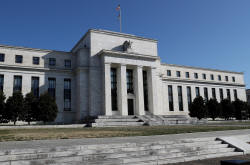Nimble cash investment needed to reap advantage of Fed tightening
 Send a link to a friend
Send a link to a friend
 [January 18, 2022] By
Karen Brettell [January 18, 2022] By
Karen Brettell
(Reuters) - For companies and other money
market investors looking to increase returns from almost zero,
opportunities should arise this year as the Federal Reserve begins
unwinding its extraordinary pandemic-era stimulus.
But navigating hikes in short-term rates, and the additional possibility
of increased issuance of government debt, to the best advantage will
take extra effort and careful strategizing.
Very short-term investors have turned to the Fed’s reverse repurchase
facility in record numbers, wherein the Fed takes cash and lends
short-term securities overnight for a 5 basis point return, as cash
holdings swell and investment options dwindle.
As rates move higher, more supply hits the market and cash holdings
shrink, these investors may now be able to put their money to better
use. On Friday investors parked $1.60 trillion in the Fed’s reverse repo
facility.
"With excess cash reduced, money market funds won't have much use for
the reverse repo facility,” said Scott Skyrm, executive vice president
in fixed income and repo at Curvature Securities.
The Fed is preparing to hike interest rate as soon as March, with three
or four increases expected this year, which will lift yields on very
short-term bills that remain near historic lows.

“The notion of rate hikes is some welcome relief, at least to cash
investors who have been plagued with near zero yields for almost two
years at this point in time,” said Jerome Schneider, head of short-term
portfolio management and funding at PIMCO.
The Treasury is also expected to ramp up issuance of Treasury bills,
after reducing it due to debt ceiling constraints last year, and this
supply is likely to grow if the U.S. central bank also begins reducing
its massive balance sheet later this year. If the Fed stops reinvesting
in bonds that have matured, the Treasury is expected to increase
short-term issuance sold to the public to make up the difference, at
least temporarily.
DON'T JUMP IN TOO FAST
Investors should be wary of buying too soon though, before rates top
out. Many short-dated assets do not reflect expected rate increases
until they occur.
Jeffrey Weaver, senior portfolio manager and head of the municipal,
short-duration fixed income, and money market teams at Allspring Global
Investments, thinks a useful strategy is to keep most investments
shorter-term until after each hike then deploy money to lock the rate
in.
“We’re reluctant to make significant purchases beyond March, which is
when we expect the first rate hike. We get to take full advantage of the
rate hike by staying short,” he said.
[to top of second column] |

Federal Reserve Board building on Constitution Avenue is pictured in
Washington, U.S., March 19, 2019. REUTERS/Leah Millis/File Photo

Alternatively, if it looks like the market is getting ahead of itself, it could
be an opportune time to invest in debt that has priced in hikes, such as debt
maturing in one or two years.
“If the market begins to price in more rate hikes than we expect then we can
take advantage of that and buy those longer securities,” Weaver added.
PIMCO’s Schneider said that investors may want to be more proactive and adopt
strategies that span different short-term assets to generate returns. That may
include trading their own strategies across various short-term assets, instead
of investing in prime money funds, which potentially face new regulatory
restrictions.
“We look at this as a period of being much more constructive for cash investors
than we saw in 2020 and largely 2021 when yields were near zero, but at the same
time the opportunity set is to be active and be dynamic and yet be patient with
how they’re thinking about managing liquidity,” he said.
This is especially true as surging inflation continues to reduce the real return
of fixed-income assets, with yields expected to remain low even if the Fed
reduces inflation back to its longer-term goal of around 2%.
The Fed’s last tightening cycle from 2015 to 2019 ended with large funding
stresses as demand for overnight loans from companies, banks and other borrowers
overwhelmed supply when the Fed reduced its balance sheet.
A repeat of such a cash crunch this time is seen as less likely since the Fed
last year established a permanent backstop to the market in the form of a
Standing Repo Facility. However, any uptick in demand for this facility may be a
warning signal.
An increase in use of the facility “would be a sign to the Fed that they need to
slow down or stop reducing the size of the balance sheet,” said Tom Simons, a
money market economist at Jefferies.

How quickly the Fed's balance sheet declines, and investors' reliance on its
reverse repo facility diminishes, will likely depend on how the economy
withstands monetary tightening.
(Reporting by Karen Brettell; Additional reporting by Gertrude Chavez-Dreyfuss
in New York; Editing by Alden Bentley and Andrea Ricci)
[© 2022 Thomson Reuters. All rights
reserved.]This material may not be published,
broadcast, rewritten or redistributed.
Thompson Reuters is solely responsible for this content. |